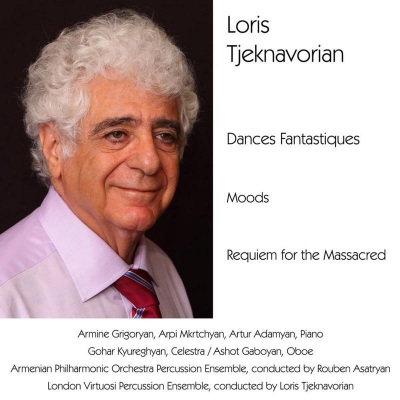
Dances Fantastiques / Moods / Requiem for the Massacred
Dances Fantastiques The original version of "Dances Fantastiques" was written for solo piano in Vienna in 1958. The Austrian pianist Winfried van den Hove premiered the piece, and performed it in a series of recitals throughout Austria, recording it the same year for Austrian Radio. In 1960, Tjeknavorian adapted the composition for three pianos, celesta and percussion, which premiered in Graz, Austria. In 1961 the composition was published by "Doblinger" and was performed in 1963 by the Salzburg Mozarteum Percussion Ensemble, conducted by Theo Alcantara. Soon afterwords it was recorded with the Percussion Ensemble of the Vienna Philharmonic Orchestra, conducted by the composer. In 1965 "Dances Fantastiques" was staged by the Interlochen Music Academy in Michigan, and the French pianist and conductor Raffi Petrossian conducted it on several occasions with the Strasbourg Percussion Ensemble in Paris and Strasbourg. The present recording was performed by the Armenian Philharmonic Percussion Ensemble and Pianists, conducted by Rouben Asatryan. The Dances Fantasique is also arranged for two pianos, celesta and percussion. “Moods” for oboe and percussion ensemble Written in 1975 in London, the Moods for Oboe and Percussion evokes the life of the immigrant-refugee, and is dedicated to the composer's father Haykas Tjeknavorian, who fled from his native country to escape the deadly persecutions of the Stalinist era. The first performance was given by Anthony Camden, principal oboist of the London Symphony Orchestra, with the London Virtuosi during the 1975-6 concert season at the Queen Elizabeth Hall in London. The US premiere took place at the University of Indiana in 1987. This recording of "Moods" was made in 1997 in Yerevan, Armenia with the soloist Ashot Gaboyan and the percussion ensemble of the Armenian Philharmonic Orchestra, conducted by Rouben Asatryan. The themes in this three-movement work were inspired by Armenian folk melodies, in particular the beloved and bittersweet traditional song "Groong" (Crane), where the migratory bird symbolizes the migrant's timeless plight. Requiem for the Massacred. for Backstage Solo Trumpet & Percussion Ensemble Requiem for the Massacred was written in London in 1973 for percussion and backstage solo trumpet, on the occasion of the 60th anniversary of the Armenian Genocide of 1915. The premiere was given in 1975 by the London Percussion Virtuosi at the Queen Elizabeth Hall, and was recorded and released later that year by Unicorn in London. The thematic material is mostly original, but also partly based on Armenian sacred music. The first movement depicts the peaceful life of a community on the eve of its persecution; the second movement depicts the scene of the deportations and the massacres. A solo trumpet (from backstage) signals the beginning of the third and fourth movements. The third movement is a requiem for the dead. The fourth movement depicts the lives of the survivors, incorporating an unfinished immigrant song "tzitzernak" swallow, played by backstage solo trumpet ending the symphony with an outcry. *The composer’s grandfather fled from western Armenia (occupied by Turkey) with his family from the Armenian Genocide of 1915 to Iran. He used to sing this particular tune, Tzitzernak.
